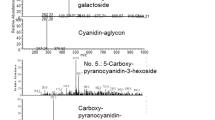Abstract
For five new clones of pomegranate, cultivated under homogeneous conditions, changes in juice anthocyanin contents during ripening were studied. Six anthocyanin pigments were found to be responsible for the red color of pomegranate juice. These were quantitatively and qualitatively analyzed by high-performance liquid chromatography and identified as delphinidin 3-glucoside and 3,5-diglucoside, cyanidin 3-glucoside and 3,5-diglucoside and pelargonidin 3-glucoside and 3,5-diglucoside. Generally, there was an increase in juice pigmentation during fruit ripening. In the early fruit-ripening stages, delphinidin 3,5-diglucoside was the main pigment, followed by cyanidin 3,5-diglucoside, while in the later stages, the monoglucoside derivatives cyanidin 3-glucoside and delphinidin 3-glucoside increased considerably. The pelargonidin derivatives were always present in small amounts.
Similar content being viewed by others
Author information
Authors and Affiliations
Additional information
Received: 1 March 1999
Rights and permissions
About this article
Cite this article
Hernández, F., Melgarejo, P., Tomás-Barberán, F. et al. Evolution of juice anthocyanins during ripening of new selected pomegranate (Punica granatum) clones. Eur Food Res Technol 210, 39–42 (1999). https://doi.org/10.1007/s002170050529
Issue Date:
DOI: https://doi.org/10.1007/s002170050529




